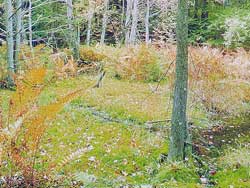Characteristic Mid-Atlantic Wetland Type - Spring Seep
Spring seeps are small wetlands typically found in sloping terrains. Groundwater reaches the surface through a distinct hole from which shallow, broad flows move outward and create a saturated zone. The groundwater typically flows year round and has a relatively constant temperature (usually between 50 and 60 degrees F). Spring seeps are essentially discharge wetlands, though they can provide recharge functions under some conditions. In winter, the warm groundwater from spring seeps melts snow, creating snow-free zones rich in food sources for wildlife. When snow depths in the West Virginia mountains are greater than 4 inches, experts estimate that spring seeps and associated streams support approximately 85% of the wild turkey feeding activity in the state. Spring seeps also are habitat for many aquatic species such as salamanders and frogs. |

A spring seep in Allegheny National Forest, Pennsylvania. Credit: Forest Service 
A spring seep in Monongahela National Forest, West Virginia. Credit: Forest Service |
National InformationCharacteristic Wetland Types for the Mid-Atlantic Region
Notable Wetland Sites in the Mid-Atlantic Region
|
![[logo] US EPA](../gif/logo_epaseal.gif)